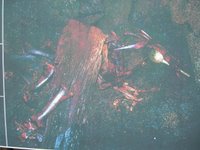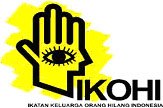4.3 Jeju Massacre
The brutality of the suppression had been largely ignored by the government, but after civil rule was reinstated in the 1990s, the government made several case of apologies for the suppression, and efforts are being made to re-assess the scope of the incident and compensate the casualties.
Finnaly, South Korean President Roh Moo-hyun Monday April 3, 2006 apologized for the massacre of civilians by government troops in 1948 in the southern island of Jeju.
 It is first time for an incumbent president to make an official apology for the 1948 Cheju massacre, in which one-tenth of the inhabitants were killed as the government sought to quell an uprising led by a small group of communist insurgents.
It is first time for an incumbent president to make an official apology for the 1948 Cheju massacre, in which one-tenth of the inhabitants were killed as the government sought to quell an uprising led by a small group of communist insurgents.
At a memorial service for victims of the April 3 uprising, Roh apologized for what he called the illegal exercise of state power against citizens of Jeju during the suppression of an armed uprising. Roh offered a formal apology to the people of Jeju Island October 2003. Monday April 3, 2006 was the first time a president attended a memorial service for those killed. The Roh administration has set up a committee to investigate the Jeju incident and has held activities to restore honor to its victims. The opposition Grand National Party has denounced Roh's actions as political maneuvering aimed at discrediting the party and its leader, Park Geun-hye, who is the daughter of former President Park Chung-hee.
A Brief History of 4.3 Jeju Massacre
 The Jeju massacre or the Cheju April 3 massacre happened as a result of suppression against armed rebellion in Jeju island, South Korea, during the period of April 3, 1948 to September 21, 1954.
The Jeju massacre or the Cheju April 3 massacre happened as a result of suppression against armed rebellion in Jeju island, South Korea, during the period of April 3, 1948 to September 21, 1954.
A complex interplay of guerilla forces, youth groups, police, local and national army together with US presence lead to the situation.
The South Korean provisional government, right-wing under U.S. guidance, conducted nationwide campaigns to root out communists and their sympathizers, which also included some moderates. This caused severe instability around the nation, and in Jeju where communist influence was stronger, many resorted to armed resistance against government action.
According to Lt. Gen. Kim Ik Ruh who was in charge of the Korean army's ground troops on the island in the first half of 1948 when the unrest began, rebels were merely labeled communist for political reasons while their true motives and slogans had nothing to do with communism, much less had there been any influence from peninsular South Korean or even North Korean communists.
He claimed the unrest had been triggered by a brutal crackdown on the islanders' smuggling, a main source of the island's income. Torture, rape, killings, arbitrary incarcerations and abductions of locals accused of being smugglers, communists or of supporting the above by police and marauding anti-communist Korean youth from the North eventually triggered a successful simultaneous attack by angry locals on all police stations on the islands on April 3, 1948.
The rebel islanders not only freed relatives from police custody in the April 3 raids, but also seized arms before retreating, giving them the upper hand on the island until reinforcements would arrive from the mainland. The police had thus been stripped of both arms and ammunition. The Korean army's 9th regiment, which had not been targeted by the rebels, was armed, but had not been allowed any ammunition as the South Korean state had not yet been formed and the United States held authority over the island.
 The government chose to mobilize the armed forces to suppress the situation and this caused many casualties. The rebellion continued after the end of Korean War. Estimates of deaths among the island's locals range from 30,000 to 80,000, between one in ten to one quarter of the population.
The government chose to mobilize the armed forces to suppress the situation and this caused many casualties. The rebellion continued after the end of Korean War. Estimates of deaths among the island's locals range from 30,000 to 80,000, between one in ten to one quarter of the population.
From various source
Finnaly, South Korean President Roh Moo-hyun Monday April 3, 2006 apologized for the massacre of civilians by government troops in 1948 in the southern island of Jeju.
 It is first time for an incumbent president to make an official apology for the 1948 Cheju massacre, in which one-tenth of the inhabitants were killed as the government sought to quell an uprising led by a small group of communist insurgents.
It is first time for an incumbent president to make an official apology for the 1948 Cheju massacre, in which one-tenth of the inhabitants were killed as the government sought to quell an uprising led by a small group of communist insurgents.At a memorial service for victims of the April 3 uprising, Roh apologized for what he called the illegal exercise of state power against citizens of Jeju during the suppression of an armed uprising. Roh offered a formal apology to the people of Jeju Island October 2003. Monday April 3, 2006 was the first time a president attended a memorial service for those killed. The Roh administration has set up a committee to investigate the Jeju incident and has held activities to restore honor to its victims. The opposition Grand National Party has denounced Roh's actions as political maneuvering aimed at discrediting the party and its leader, Park Geun-hye, who is the daughter of former President Park Chung-hee.
A Brief History of 4.3 Jeju Massacre
 The Jeju massacre or the Cheju April 3 massacre happened as a result of suppression against armed rebellion in Jeju island, South Korea, during the period of April 3, 1948 to September 21, 1954.
The Jeju massacre or the Cheju April 3 massacre happened as a result of suppression against armed rebellion in Jeju island, South Korea, during the period of April 3, 1948 to September 21, 1954.A complex interplay of guerilla forces, youth groups, police, local and national army together with US presence lead to the situation.
The South Korean provisional government, right-wing under U.S. guidance, conducted nationwide campaigns to root out communists and their sympathizers, which also included some moderates. This caused severe instability around the nation, and in Jeju where communist influence was stronger, many resorted to armed resistance against government action.
According to Lt. Gen. Kim Ik Ruh who was in charge of the Korean army's ground troops on the island in the first half of 1948 when the unrest began, rebels were merely labeled communist for political reasons while their true motives and slogans had nothing to do with communism, much less had there been any influence from peninsular South Korean or even North Korean communists.
He claimed the unrest had been triggered by a brutal crackdown on the islanders' smuggling, a main source of the island's income. Torture, rape, killings, arbitrary incarcerations and abductions of locals accused of being smugglers, communists or of supporting the above by police and marauding anti-communist Korean youth from the North eventually triggered a successful simultaneous attack by angry locals on all police stations on the islands on April 3, 1948.
The rebel islanders not only freed relatives from police custody in the April 3 raids, but also seized arms before retreating, giving them the upper hand on the island until reinforcements would arrive from the mainland. The police had thus been stripped of both arms and ammunition. The Korean army's 9th regiment, which had not been targeted by the rebels, was armed, but had not been allowed any ammunition as the South Korean state had not yet been formed and the United States held authority over the island.
 The government chose to mobilize the armed forces to suppress the situation and this caused many casualties. The rebellion continued after the end of Korean War. Estimates of deaths among the island's locals range from 30,000 to 80,000, between one in ten to one quarter of the population.
The government chose to mobilize the armed forces to suppress the situation and this caused many casualties. The rebellion continued after the end of Korean War. Estimates of deaths among the island's locals range from 30,000 to 80,000, between one in ten to one quarter of the population.From various source





